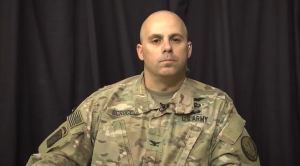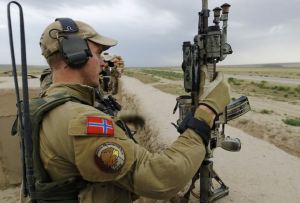Christof Lehmann (nsnbc) : Syrian military sources reported that the U.S.-led coalition carried out an attack on Syrian military forces near the Al-Tanf road in al-Shahima on Tuesday. The term de-conflicting zones was used. However, Russia stressed that the U.S. cannot unilaterally impose such zones. Actual details about the incident as well as the legal context are sketchy. nsnbc asked USCENTCOM for clarification – given the risk that the international community could be regressing to lawlessness under UN cover we had a set of pertinent questions.
Syrian military sources reported that the U.S.-led coalition, on Tuesday at 17:40 local time, carried out “an attack on a Syrian Arab Army position on the al-Tanf road in al-Shahima, in the eastern countryside of Homs province”. Syrian military sources reported that the attack claimed “a number of lives and caused material damage”.
No exact casualty numbers were released. Statement issued by the Syrian Arab Army are also notoriously ambiguous about the use of the term Syrian military forces. The term can cover forces of the Syrian Arab Army, Popular Self Defense Forces, and a cohort og other forces allied with the government of the Syrian Arab Republic.
The Syrian Arab Army (SAA) also affirmed that it, and its allies, are determined to continue fighting terrorist organizations, primarily ISIS and Jabhat al-Nusra, and pursue them across Syrian territory. Local sources on the ground, however, reported to nsnbc that there are neither ISIS nor Jabhat Al-Nusra forces were operating in the proximity of the area where the “coalition” strike was carried out on Tuesday.
The fog of war?
Back on May 18th, US-led coalition aircrafts attacked a what the Syrian Arab Army described as a “Syrian Army” position, while the U.S.’ Defense Department claimed it struck “Iranian controlled fighters allied with the Syrian regime” in al-Tanf in the Badiya desert. However, as far as nsnbc is informed, the only “pro-government” forces operating in the area were units from the Syrian Arab Army, National Self Defense Forces, Hezbollah, Druze militia and militants from Syria’s Social National Party. Also present were U.S. special forces, Norwegian special forces, in liaison with U.S. backed militants.
In other words, if USCENTCOM’s statement that “Iranian-controlled fighters” were targeted, this would – arguably – best be translated by stating “Hezbollah was targeted”. We are, in other words, back to the problem that statements issued by the General Command of the Syrian Arab Army are as non-specific when the term Syrian military units is used, as the USCENTCOM is non-specific when it reports that it targeted “pro-regime forces” in an alleged “de-conflicting zone”.
In late May, following the incident on May 18, USCENTCOM’s Col Joseph Scrocca told this author in an email in response to questions about the U.S. air raid:
Coalition special operations forces train and equip, advise, assist, accompany and enable two Vetted Syrian Opposition (VSO) groups to fight ISIS in the Jordan-Syria-Iraq /tri-border) area of southern Syria. The two VSO groups are the Mahhawir al Thawra (MaT) and the Shohada al-Quartayn (ShQ), two Syrian tribal groups whose homelands include the Qalamoun Mountain region, Euphrates River Valley and the Hamad Desert, which stretches from the Jordan border north along the Iraqi border to the Euphrates River. Very little, if any information about the Mat and ShQ is accessible in English or Arabic language, so it would be hard to tell anything about these groups allegiances, by whom they are controlled, of other important facts.
Dispute about so-called de-conflicting zones
On Wednesday Russian Foreign Minister Sergey Lavrov affirmed that the bombing of one of the positions of what he designated as “the Syrian army on al-Tanf road in the eastern countryside of Homs”, by the U.S.-led coalition, was a violation of international law. In a joint press conference with his Spanish counterpart Alfonso Dastis in Moscow, Lavrov stressed Russia’s non-recognition of the “de-confliction zones” that the United States is trying to impose in Syria unilaterally.
Lavrov said Russia, Turkey and Iran have signed an agreement, which has been endorsed by the UN Security Council, to establish so-called “de-escalation zones” in several parts of Syria. Damascus agreed to this approach and the exact borders and mechanisms for observing a truce inside those zones are currently being negotiated. “This approach was agreed to by Syria. We consider illegitimate any unilateral declaration of ‘de-confliction zones’ not endorsed by Damascus. We hope the coalition will adhere to the agreement it has reached with us, which states that the de-escalation zones must be agreed to in detail by all stakeholders,” he said.
More questions to USCENTCOM’s Col Scrocca
On Thursday, nsnbc sent a number of new questions to USCENTCOM and Col Joseph Scrocca. We asked:
Did the U.S.-led coalition carry out the above mentioned operation.. If so, forces from what country (coalition partner) were involved. * In case the answer was yes, what preceded the order to carry out the operation and on whose orders was it carried out and why? * What exact forces were targeted in this operation? Syrian Arab Army forces? Or other forces allied to the Syrian government? In that case, exactly which forces? * We hear the word “de-escalation zone” or “de-conflicting zone” within the context of this incident. Would the U.S.-led coalition consider the area around al-Tanf as such a zone? If so, based on whose decision, what decision and when was it made?
* From your Norwegian colleagues we heard that the legal basis for operations in the Iraq – Jordan – Syria tri-border area and the presence of Norwegian (special) forces also in Syria is based on UNSC Resolution 2249 and UN Charter Article 51.. Basically this means – Iraq called on “the international community” to assist in the fight against ISIS – ISIS poses an international threat – the government of the Syrian Arab Republic is either unwilling or incapable of combating ISIS effectively and therefore, operations in Syria can be interpreted as self-defense… Question here is – do you use the same legal interpretation and justification for the above mentioned operation – if yes, please explain briefly, if no, under what legal construct was the above mentioned attack carried out. If you please could answer these questions for clarification – for starters. What really makes this incident interesting is that there are – contrary to Raqqa – no ISIS forces present near al-Tanf, so we would be sleeping on our watch as journalists if we didn’t ask what exactly is happening and why. I guess you understand. … Looking forward to hearing from you. .. With warm regards. Christof Lehmann, Editor-in-Chief, nsnbc international ….
We will of course inform the reader when we have received clarifying answers from Col Scrocca or USCENTCOM.
Laws as social constructs in an ever more complex theater of war
While we are still waiting for clarifications from USCENTCOM, one may have a look at the Norwegian – keeping in mind that the position of other “coalition” members with regard to international law and the presence of their forces in Syria is likely to be – at least more or less – identical. The author asked Norwegian LtC Sølvsberg about the presence of Norwegian special forces in the region around al-Tanf during the incident on May 18. LtC Sølvsberg” and replied:
We are aware that Norway deployed forces within the Inherent Resolve Framework to Jordan and Iraq, but that did not answer our question about Syria. .. Could I have a clear statement about that (and the other questions) or how would you suggest we proceed with a cooperation that takes into account your military mission and our obligation to deliver decent and objective journalism. … Alternatively, please send name, rank, mail address for a person directly in charge of the Norwegian participation in Inherent Resolve. We might have a better chance to find a feasible solution. … Below you find links to publicly accessible information from the Norwegian MoD to answer some of your questions concerning mandate and mission. … We have a policy of not giving operational information about our special forces. This is also the case with our forces working out of Jordan. All media, domestic and international, are treated equally on this matter.
We looked at LtC Sølvsberg reply and deconstructed it, point by point. Not giving information about “operational details” for special forces is not unusual, but we asked for the name of the unit. We also asked about these trops in “Syria” and not about their absolutely legal presence in Jordan. We also asked for the foundation for their deployment to “Syria” according to Norwegian or international law. Sølvsberg did not as much as begin to answer these (and the other questions above) in his statement. So let us see what the “publicly accessible information from the Norwegian MoD” tells us.
- Iraq, in 2014, had requested help from the UN Security Council to combat ISIL, including attacks by ISIL launched from Syrian territory. Moreover, it states that the Norwegian presence in Iraq today is based on the Iraqi request for help based on the UN Charter’s Article 51 on collective self-defense.
- That ISIL can’t be defeated by limiting the fight to Iraq.
- That UN Security Council resolution 2249 from November 20, 2015 concludes that ISIL poses an extraordinary threat to international peace and security.
- That the UNSC called on its members to fight ISIL everywhere, including its enclaves in Syria.
- That self-defense against non-state actors who operate on the territory of another state while this state is unwilling or incapable of combating such non-state actors, is legal and covered by the provisions of UNSC resolution 2249.
The other “publicly accessible information” LtC Sølvsberg sent to this author was a press release from Norway’s Defense Ministry quoting Defense Minister Eriksen Søreide repeating the above mentioned. The third document is a memo styled to the Foreign Ministry’s Foreign Affairs Council, repeating the same arguments UNSC resolution 2249 UN Charter Article 51 and the claim of self-defense against ISIL because Syria is unwilling or incapable. The document is from January 20, 2016. The fourth and final information LtC Sølvsdahl referred to is another press release from March 27, 2017, in which Norway’s Defense Ministry announced that it has extended its operations against ISIL.
Regression to lawlessness under UN cover? Who’s next?
The position is interesting – and potentially dangerous – It suggests that social constructionism and positioning with regard to international law and UNSC resolutions has led to a situation where an “anything goes” and “utilitarianism based on positioning” led to actual lawlessness or disregard for the intended function of laws.
If applied, any UN member could “join any coalition against international terrorism” based on “any relevant UNSC resolution” to then invade “any country where a covered terrorist organization has a presence”, claiming that “the government and military of that country is unwilling or incapable of fighting this international threat”, and claiming that such an aggression constitutes “self-defense under the UN Charter’s Article 51″.
Provided that this interpretation has standing or is allowed to stand, the inevitable question is “who’s next” on the list? Pakistan – because Taliban and ISIS is present there, in this nuclear-armed country? Afghanistan – even if it decides to ask foreign militaries to leave? The Philippines – because of the ISIS insurgency in Mindanao? The United Kingdom – because it can’t stop alleged ISIS attacks in Manchester and London? Iran – after the alleged ISIS attack on the parliament in Tehran on June 7, 2017? Let’s leave it at this for the time being and while we are waiting for answers from USCENTCOM and Col Scrocca.
CH/L – nsnbc 08.06.2017
Source Article from https://nsnbc.me/2017/06/08/us-air-strike-in-al-shahima-syria-regressing-into-lawlesness-under-un-cover/
 RSS Feed
RSS Feed















 June 8th, 2017
June 8th, 2017  Awake Goy
Awake Goy 












 Posted in
Posted in  Tags:
Tags: 













